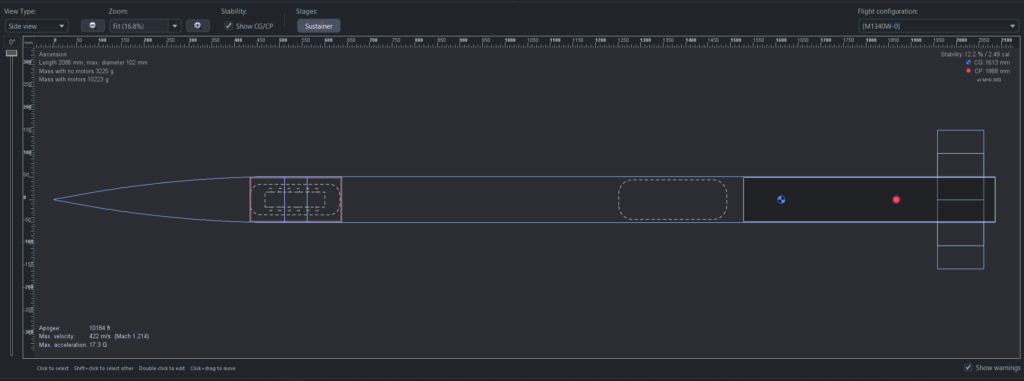June 8, 2024
“If you want to have a maximum effect on the design of a new engineering system, learn to draw. Engineers always wind up designing the vehicle to look like the initial artist’s concept.” –Akin’s Laws of Spacecraft Design, #30.

Well, I’m no artist, but there’s the first concept for what Ascension will actually look like. You know. Everything else pending.
I find when dealing with the concept stage of massive projects like this – you tend to already have a mental image of what you want to build, but the challenge is in taking a relatively uninspiring and sterile set of requirements and fusing it with the weakly-defined yet idealized vision in your head. It’s really easy to sit and imagine launch day and all that comes with it, but to get there, you’ve got to work from both ends and meet in the middle.
Chipping away from the other end, I’ve also started loading up an OpenRocket simulation of Ascension. This is a nice and quick way to throw in some initial assumptions and get a result out – a rough order of magnitude estimate of what to expect before moving forward with in depth design.

That looks something like this. It’s best to think of models like this as a set of inputs and outputs. The initial assumptions here:
- Motor: Aerotech M1340W. This is a single-use, 98mm M motor largely intended for L3 certs. (They also run for about $700 these days. Ouch.)
- Airframe: 4″ filament-wound fiberglass. Went for a main body tube length of 60″, with tube fins that are 4″ by 4″ each.
- Avionics/Recovery: Modeled a rough avionics bay with a 300-gram dead weight to roughly approximate the weight of a flight computer. The layout of the rocket also assumes a recovery mode known as “head-end dual deployment” – with a computer deploying a small drogue parachute located in the nosecone itself at apogee and a main located in the body tube at a set altitude. OpenRocket can simulate recovery itself to some extent – but we’re not quite worried about this yet. There’s a second 300g weight near the motor to stand in for a parachute and recovery harnessing.
- Simulation Environment: We’re assuming a launch site 2,000 ft above sea level, a bit over 90 degrees Fahrenheit (~32 C). This is about accurate for launching from the Mojave.
In turn, we get the following outputs:
- Dry / Loaded Mass: 3225g unloaded, 10223g loaded
- Apogee: 10,184 ft (3,104 m) above ground level
- Max velocity: 422 m/s, Mach 1.21 (943 mph)
- Stability: 12.2% (2.49 cal) at Mach 0.3, increasing to 3.2 cal at Mach 1.2
For those keeping score at home, these satisfy our initial requirements in LOG-001 pretty well. We’ve got considerable margin to our 15,000 ft ceiling (requirement L3-003), met the 10% stability requirement (L3-004), and have very good margin to the never-exceed velocity of Mach 2 (L3-005). This is, all things considered, a pretty calm flight regime for an L3-class build. I know Mach 1.21 doesn’t sound calm to the uninitiated, but trust me, it is.
Nominally, you’d probably want to trade a few concepts here and see what works best. But to be fully honest, I’d like to build a tube-fin rocket anyways (as an upscale of my very scrappily built L2), and we’ve pretty squarely achieved the requirements at hand anyways. Process is a big part of this project, but this early into the conceptual stage, it’s okay to go “that works” – especially with prior flight experience to back it up.
At any rate, progress on the other fronts is slowly trucking along. I’ve organized a few of my existing rocketry supplies a bit more as I try to get everything all in one place for this build. I’m also adding a new requirement (as decided right now) that this build should have at least one HD camera onboard. If we’re going 4″, we have the space for it, and I think Joe Barnard laid out the argument for more cameras on rockets pretty well the other day.
For the near term, my main focus is going to be on finalizing the requirements and conceptual design for the rocket – likely with a little more attention to the avionics and other details. I’m also working on taking inventory of what rocketry supplies I already do have – it might be about time for me to get a label maker and load up a spreadsheet.
Stay tuned for that update – coming eventually. I’m about to get really busy with a ton of other things, so I’ll be doing my best to try to keep this project chugging along, but there’s gonna be a lot to juggle in between.
until then, fly safe
– lavie
Leave a Reply